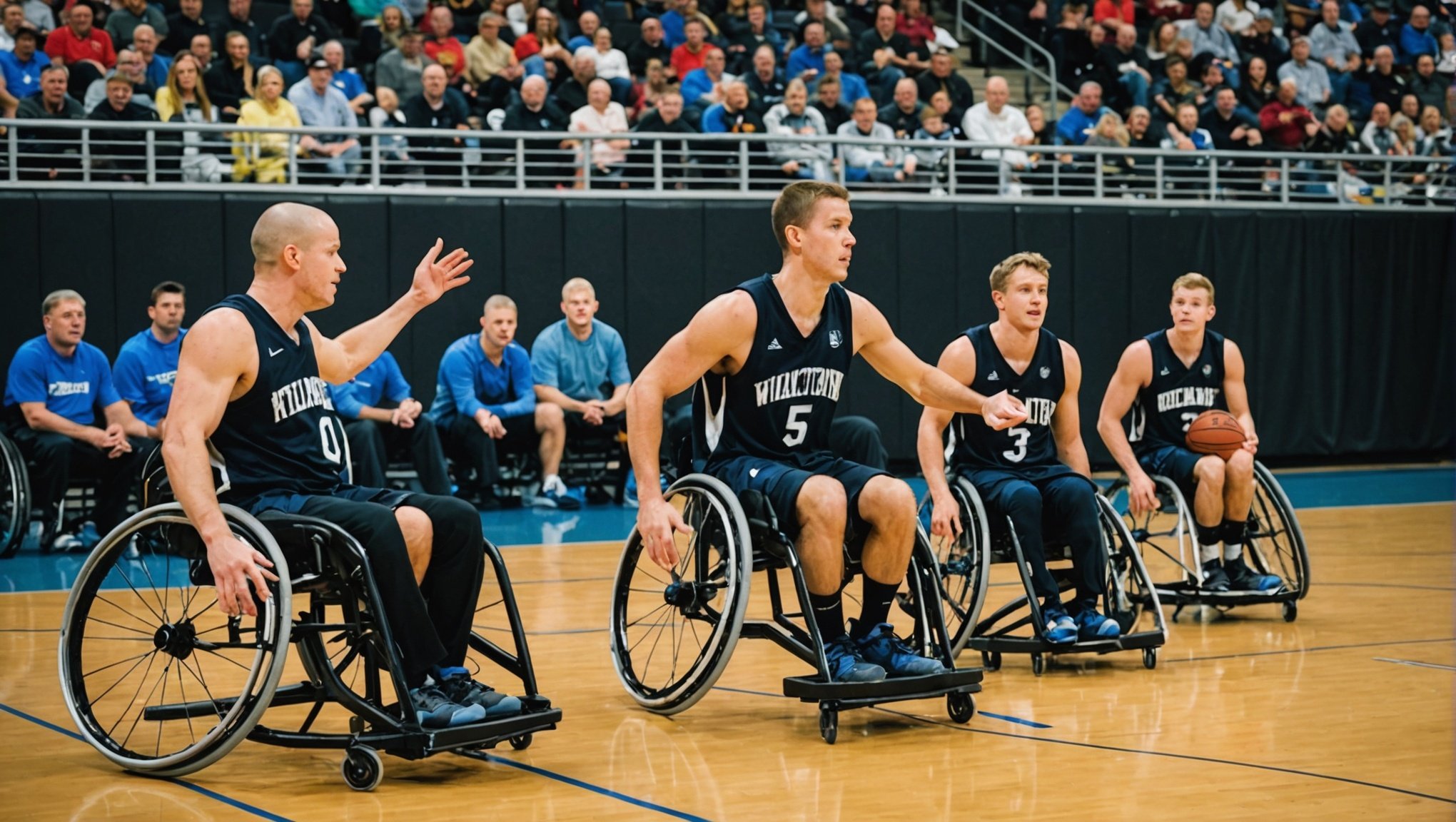Maximizing Performance: Essential Tips for Wheelchair Basketball Athletes to Fine-Tune Their Chair Setup
Understanding the Importance of Wheelchair Setup in Basketball
When it comes to wheelchair basketball, the setup of the chair can be the difference between a good game and a great one. Athletes with disabilities, just like their able-bodied counterparts, rely heavily on their equipment to enhance their performance. In wheelchair basketball, the chair is not just a tool for mobility; it is an integral part of the athlete’s overall physical fitness and strategy.
“Adaptive equipment not only enhances performance but also fosters a sense of independence and confidence in individuals with disabilities,” notes a study on adaptive sports equipment.
Also to discover : Unlocking Peak Performance: Strategies for Biathletes to Boost Skiing Efficiency with Focused Strength Training
Choosing the Right Wheelchair
The first step in fine-tuning your wheelchair setup is selecting the right chair. For competitive basketball players, a performance wheelchair designed specifically for the sport is crucial.
Top End Paul Schulte 7000 Series Basketball Wheelchair: A Case Study
One of the top choices for elite wheelchair basketball athletes is the Top End Paul Schulte 7000 Series Basketball Wheelchair. This chair is engineered with a 7000 series aluminum frame, which offers exceptional strength while remaining ultra-lightweight. Here are some key features that make this wheelchair stand out:
In parallel : Unlocking Peak Fielding Agility: Strategies for Professional Cricketers to Elevate Their Game
- Custom Camber and Seat Positioning: Fully customizable seat height and camber settings allow players to achieve optimal balance and control.
- Offensive Wing Design: The frame features a built-in offensive wing that helps deflect competitors and protect the chair during high-intensity play.
- High-Performance Wheels: Players can choose from a variety of performance wheels designed for quick turns and superior traction on the basketball court.
- Ergonomic Seat and Backrest: Customizable seat width, depth, and backrest angles for enhanced comfort and control during fast-paced play.
Customization Options for Optimal Performance
Customization is key to maximizing performance in wheelchair basketball. Here are some essential customization options to consider:
Frame Style and Size
Adjusting the frame dimensions to fit the athlete perfectly can significantly impact comfort and performance. A well-fitted frame ensures better stability and maneuverability.
Camber Angle
The camber angle affects the stability and turning ability of the wheelchair. Athletes can select their preferred camber angle to improve their performance on the court.
Wheel Options
Choosing the right wheels can make a significant difference in game performance. High-performance wheels designed for quick turns and superior traction are essential for competitive play.
Seat and Back Adjustments
Fine-tuning the seat width, depth, and backrest angle to match the athlete’s posture and performance needs is crucial. This ensures maximum comfort and control during the game.
Additional Features
- Adjustable Center of Gravity: Fine-tuning the chair’s center of gravity for personalized control.
- Speed and Agility: Engineered for fast and smooth movements across the court.
- Camber Clamp Assembly: Improves balance and performance on the court.
Physical Fitness and Injury Prevention
Physical fitness is a cornerstone of any athletic performance, and wheelchair basketball athletes are no exception. Here are some tips to maintain peak physical fitness and prevent injuries:
Upper Extremity Strength
Wheelchair basketball athletes rely heavily on their upper extremities for propulsion and maneuverability. Engaging in exercises that strengthen the arms, shoulders, and back is essential.
Core Strength
A strong core provides stability and balance, which are critical for quick turns and high-intensity play.
Flexibility and Mobility
Maintaining flexibility and mobility in the shoulders, elbows, and wrists can help prevent injuries such as tendonitis and strains.
Functional Classification
Understanding the functional classification of wheelchair basketball can help athletes tailor their training and chair setup to their specific needs. The International Wheelchair Basketball Federation (IWBF) classifies players based on their functional ability, which helps in creating balanced teams and ensuring fair competition.
Practical Tips for Fine-Tuning Your Wheelchair Setup
Here are some practical tips to help you fine-tune your wheelchair setup for optimal performance:
Regular Maintenance
Regular maintenance of your wheelchair is crucial. Check the wheels, bearings, and frame for any damage or wear and tear. Lubricate the wheels and bearings to ensure smooth movement.
Push Rim Technique
The push rim technique is vital for efficient propulsion. Practice different push rim techniques to find what works best for you.
Court Testing
Test your wheelchair setup on the court before a game. Make any necessary adjustments to ensure you are comfortable and performing at your best.
Consult a Scholar or Coach
Consulting with a sport psychology professional or a coach who specializes in wheelchair sports can provide valuable insights into optimizing your chair setup and overall performance.
Table: Comparison of Key Features in High-Performance Wheelchairs
| Feature | Top End Paul Schulte 7000 Series | Other High-Performance Wheelchairs |
|---|---|---|
| Frame Material | 7000 Series Aluminum | Carbon Fiber, Aluminum |
| Custom Camber | Fully Customizable | Limited Customization |
| Wheel Options | High-Performance Wheels | Standard Wheels |
| Ergonomic Seat | Customizable Seat Width, Depth | Fixed Seat Dimensions |
| Backrest Adjustments | Customizable Backrest Angles | Fixed Backrest |
| Center of Gravity | Adjustable | Fixed |
| Additional Features | Offensive Wing, Anti-Tip Wheels | Basic Safety Features |
Real-Life Examples and Anecdotes
Paul Schulte: A Pioneer in Adaptive Sports
Paul Schulte, a Paralympian and designer of the Top End Paul Schulte 7000 Series Basketball Wheelchair, is a prime example of how the right equipment can transform an athlete’s performance. Schulte’s involvement in designing wheelchairs has led to the creation of highly customizable and performance-oriented chairs that have helped numerous athletes achieve their full potential.
Overcoming Challenges
Athletes with spinal cord injuries or other disabilities often face unique challenges. However, with the right wheelchair setup and physical training, these athletes can overcome these challenges and perform at a high level. For instance, a study on adaptive sports highlighted how athletes with disabilities can benefit from sport psychology consulting to enhance their performance and mental well-being.
Maximizing performance in wheelchair basketball is a multifaceted process that involves selecting the right wheelchair, customizing it to fit the athlete’s needs, maintaining peak physical fitness, and preventing injuries. By understanding the importance of each aspect and applying practical tips, athletes can fine-tune their chair setup to achieve optimal performance on the court.
In the words of Paul Schulte, “The right equipment can make all the difference in competitive sports. It’s about finding that perfect balance between comfort, control, and performance.”
Whether you are an experienced player or a rising star in the world of wheelchair basketball, investing time and effort into fine-tuning your chair setup will undoubtedly enhance your game and take your performance to new heights.






